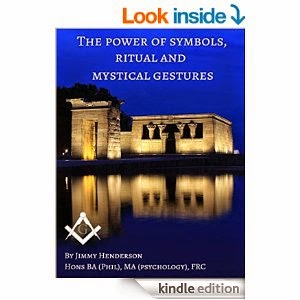By Jimmy Henderson FRC
When considering the power of
ritual, it will be seen that symbols, symbolic images and actions form the
basis of ritualistic ceremonies, which could really be said to be dramatizations
(similar to a play), in which great truths concerning man, soul, God and
reality are presented.
As in the case of a screenplay,
each ritual has a ‘script’ as well as a number of different ‘dimensions’ in
which the sacred truths and symbolic messages are concealed.
These dimensions include the
actual setting up of the ritual, such as the backdrop, layout, lighting, positioning
of the furniture or props and the background music. All these have a symbolic meaning
and normally set the context for the ritual.
For example, the effective
use of appropriate furniture, lighting and music is a powerful tool in creating
a certain ambiance of dignity and respect which prepares the participants
mentally and emotionally to respond to subliminal messages or impressions and to
assimilate new inner experiences. Subliminal messages framed by the setting
could include: ‘This is a sacred place’; ‘This is a place of learning’; or;
‘This is an important ritual’. Whether or not participants actually notice these
messages will depend on their openness and readiness, which will be discussed
later.
The second dimension comprises
of the actual characters (office-bearers) in the ritual. Each person has a
symbolic role, also full of meaning. Once again, the dress and regalia of each
office-bearer conveys a certain message and contributes to the overall theme
and significance of the ritual.
The third dimension, which
is very important, is the activities which take place. These activities embody the
‘script’ that is being enacted and each scene, movement and gesture would
present an important symbolic message which has to be interpreted
metaphorically. For instance, being called to enter via a portal or doorway
would imply that a decision has to be made (whether to enter or not) and suggests
that the member may (symbolically) be entering a higher level of knowledge or
purity.
Each action, such as the
summoning of a candidate or making him (or her) move in a specific direction,
would also have a deeper metaphorical meaning. For example, a gesture to enter
a room or specific area of the temple could symbolically imply an invitation to
enter into a higher level of knowledge or illumination. During initiations or
installations, a change in the dress or sitting position of the candidate could
also symbolically denote a change in the candidate’s status.
During the ritual, each observer
or participant should be asking himself (or herself) what the symbolic meaning
of this particular activity is, and how it affects him/her emotionally and
psychologically. In this way the ritual creates an opportunity for reflection
and introspection, and for all present to benefit intellectually and spiritually
from what is being enacted or conveyed. Once again, whether this actually
happens, depends on the participation and state of mind of the member
concerned. .
The final dimension of the
ritual is comprised of the symbolic objects or props that are used. Once again,
each has a special meaning which adds to the overall message of the enactment.
These meanings can usually be gleaned by applying metaphors to their everyday
use.
For example, a candle would
be a symbol of light (illumination in the darkness of ignorance), and a ceremonial
sword a symbol of power and authority (it has the power to subdue others).
The true power of ritual therefore
relates to its ability to bring about changes in our emotional and psychological
experience with a view to creating a readiness to receive impressions and
communications from the subconscious mind or even the God-Mind. Normally, a
special level of ‘mindfulness’ is
required for this, such as occurs during meditation, an altered state of consciousness
in which our thinking is quieted, our brainwave patterns slowed down, and we
open direct channels to the subconscious mind. This in turn, can lead to clearing
of the pathway to the God-mind and spiritual knowledge being more easily
communicated.
However, the solemnity, dedication,
focus, activities and symbolism of the ritual are such that it can also produce
a similar conscious state, one which also allows for the opening of the
subconscious mind and the transfer of inspired thoughts and hidden truths.
The aim of ritual is
therefore to prime our minds for the inflow of sacred knowledge and divine illumination.
As mentioned, this requires a certain state of readiness in which the mind has
been gradually prepared through guided studies and discipline, as would be provided
by fraternal organisations based on the
ancient mystery schools such as the Freemasons and Rosicrucians
which offer graded teachings with structured degrees of learning having a high
moral and spiritual basis.
Jimmy Henderson (MA Psychology) FRC, is a Rosicrucian and cognitive specialist who has published many books and articles on metaphysical subjects. His psychological approach makes the information all the more credible. See Amazon.com (Jimmy Henderson) for a list of his books.


